Egypt - Red Sea Liveaboard Fleet
North & Brothers
The Brother Islands are the pinnacles of two undersea mountains rising from the depths of the abyss and are located about 60 miles offshore. Part of the Marine Park Islands National Park, these islands offer stunning wall diving, with the walls covered in soft corals and forests of gorgonians, creating a kaleidoscope of ever-changing colours. They attract a diverse array of marine species and large pelagics. Large tuna, jacks and snappers cruise in the blue, accompanied by occasional hammerheads, silvertips, silky and oceanic white tip sharks and mantas. Even the rare thresher shark can be found here. Sightings of the grey reef shark are almost guaranteed on the North and South Plateaux of Small Brother.
For the wreck diver, the Aida II, an Egyptian supply vessel, and the Numidia, a cargo ship, lie on the walls of the Big Brother. Both are covered in a rich growth of soft and hard corals. Marine life includes a family of Napoleon wrasse and grey reef sharks.
Daedalus Reef, also part of the Marine Park, is a large, oval reef with a lighthouse and is the furthest offshore reef in the Egyptian Red Sea. Its deep walls and drop-offs offer some of the most spectacular diving to be found. Daedalus has mountainous, pristine, hard coral formations. There is also a strong chance of spotting schooling hammerheads and grey reef sharks.
Elphinstone is approximately 30km from Port Ghalib; Elphinstone reef is 300 metres long with sheer walls richly covered in colourful pink and red soft corals and elegant red gorgonians descending to around 40 metres. Other areas of the reef have near vertical cliffs, overhangs, small caves and drop offs of up to 100 metres. Elphinstone is known to experience some strong currents attracting many diverse species such as barracuda, angel fish, groupers, Napoleons, morays, reef sharks and great shoals of dogtooth tuna and jacks. Occasional sightings include dolphins, turtles, oceanic white tip and hammerhead sharks.
Itinerary Highlights
-
 Best Top 3 sites in the southern Red Sea: Big and Little Brothers, Daedalus Reef and Elphinstone
Best Top 3 sites in the southern Red Sea: Big and Little Brothers, Daedalus Reef and Elphinstone
-
 Sheer walls draped in colourful soft corals and gorgonian forests.
Sheer walls draped in colourful soft corals and gorgonian forests.
-
 Wrecks of Aida II and Numidia richly covered with soft and hard corals.
Wrecks of Aida II and Numidia richly covered with soft and hard corals.
-
 Strong currents nourish offshore reefs with a diverse range of marine life such as tuna, barracudas, jacks, groupers, Napoleon, snappers and reef sharks.
Strong currents nourish offshore reefs with a diverse range of marine life such as tuna, barracudas, jacks, groupers, Napoleon, snappers and reef sharks.
-
 Occasional hammerheads, silky and oceanic white tips, dolphins and mantas. Rare chance to spot threshers.
Occasional hammerheads, silky and oceanic white tips, dolphins and mantas. Rare chance to spot threshers.
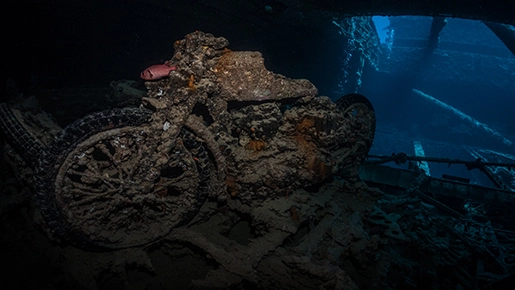 Arguably one of the most famous and best wrecks in the world, the SS Thistlegorm was sunk in World War II with a full load of trucks, ammunition and supplies. She's a living museum of the war and should be dived at least twice to get a real taste of the wreck and all her cargo, which is scattered around the site. When conditions permit, night dives are an amazing experience and an opportunity to explore a special piece of underwater history.
Arguably one of the most famous and best wrecks in the world, the SS Thistlegorm was sunk in World War II with a full load of trucks, ammunition and supplies. She's a living museum of the war and should be dived at least twice to get a real taste of the wreck and all her cargo, which is scattered around the site. When conditions permit, night dives are an amazing experience and an opportunity to explore a special piece of underwater history.
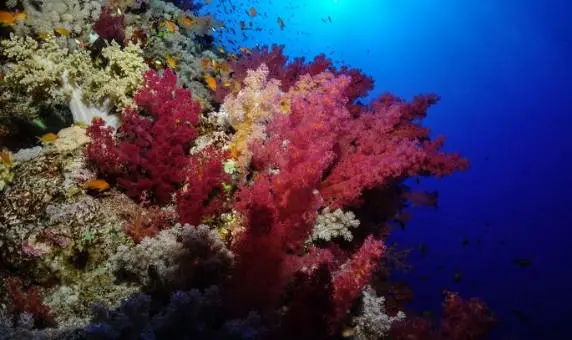 These islands offer some incredible marine life with the possibility of spotting hammerheads, oceanic white tips, silky sharks, manta rays and the occasional thresher shark. You may also see jackfish, snappers and large tuna. Brothers offer incredible wall diving and two wrecks on the Big Brother – Aida at 30-60m and Numidia at 10-85m (not for recreational divers). This is a spectacularly diverse location, packed with vibrant corals and forests of gorgonians. With breathtaking scenery, there are over a dozen world-class sites that can be dived here.
These islands offer some incredible marine life with the possibility of spotting hammerheads, oceanic white tips, silky sharks, manta rays and the occasional thresher shark. You may also see jackfish, snappers and large tuna. Brothers offer incredible wall diving and two wrecks on the Big Brother – Aida at 30-60m and Numidia at 10-85m (not for recreational divers). This is a spectacularly diverse location, packed with vibrant corals and forests of gorgonians. With breathtaking scenery, there are over a dozen world-class sites that can be dived here.
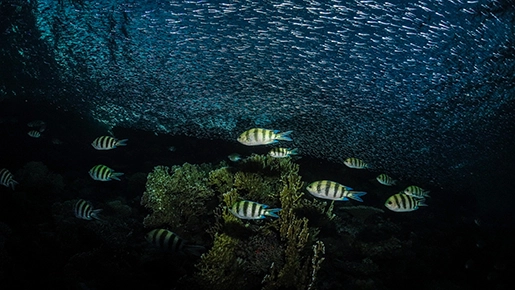 Home to vibrant and healthy coral reefs and a family of friendly bottlenose dolphins, the Gubal Islands offer several dive sites and two exceptional wrecks. The Ulysses sits on her port side at maximum depth of 28m. A stunning artificial reef that's bursting with marine life, wreck penetration is straightforward and easy. The opportunity to explore the cargo scattered around the wreck gives a fascinating insight into the goods carried along the Suez in the late 19th Century. The Barge sits at 15m and we moor directly above her. She's one of the best night dives in the Red Sea and offers incredible opportunities for photography. There are thousands of fish on this wreck. Keep a look out for George and Georgina, two peaceful giant morays who've made the Barge their home.
Home to vibrant and healthy coral reefs and a family of friendly bottlenose dolphins, the Gubal Islands offer several dive sites and two exceptional wrecks. The Ulysses sits on her port side at maximum depth of 28m. A stunning artificial reef that's bursting with marine life, wreck penetration is straightforward and easy. The opportunity to explore the cargo scattered around the wreck gives a fascinating insight into the goods carried along the Suez in the late 19th Century. The Barge sits at 15m and we moor directly above her. She's one of the best night dives in the Red Sea and offers incredible opportunities for photography. There are thousands of fish on this wreck. Keep a look out for George and Georgina, two peaceful giant morays who've made the Barge their home.
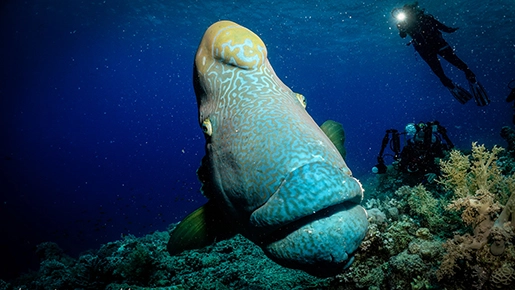 One of the most beautiful and protected dive locations in the world, Ras Mohamed national park offers over a dozen exceptional dive sites. Full of vibrant marine life, it's not to be missed! With visibility up to 40m (dependent on weather conditions), you'll encounter an incredible variety of species including jacks, snappers and tuna and occasional sharks and rays. The iconic wreck of the Yolanda can also be found here with its payload of toilets scattered around her. Please note that night diving is prohibited within the national parks.
One of the most beautiful and protected dive locations in the world, Ras Mohamed national park offers over a dozen exceptional dive sites. Full of vibrant marine life, it's not to be missed! With visibility up to 40m (dependent on weather conditions), you'll encounter an incredible variety of species including jacks, snappers and tuna and occasional sharks and rays. The iconic wreck of the Yolanda can also be found here with its payload of toilets scattered around her. Please note that night diving is prohibited within the national parks.
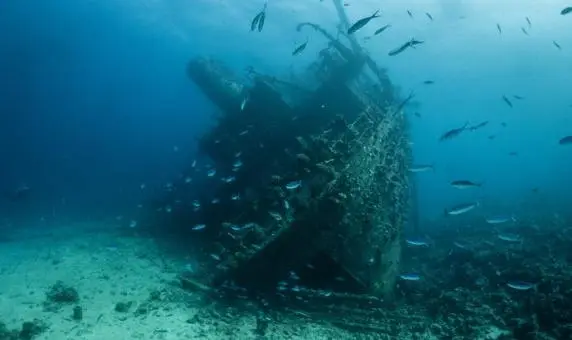 Four wrecks situated close together make this an excellent location for wreck divers and underwater photographers, with all being suitable for recreational divers. Giannis D, Carnatic, Chrisoula K and Kimon M are covered in soft and hard corals and there are often bottlenose dolphins in the area. The engine room and machine rooms are easily accessible on the Chrisoula K and Giannis D.
Four wrecks situated close together make this an excellent location for wreck divers and underwater photographers, with all being suitable for recreational divers. Giannis D, Carnatic, Chrisoula K and Kimon M are covered in soft and hard corals and there are often bottlenose dolphins in the area. The engine room and machine rooms are easily accessible on the Chrisoula K and Giannis D.
 Arguably one of the most famous and best wrecks in the world, the SS Thistlegorm was sunk in World War II with a full load of trucks, ammunition and supplies. She's a living museum of the war and should be dived at least twice to get a real taste of the wreck and all her cargo, which is scattered around the site. When conditions permit, night dives are an amazing experience and an opportunity to explore a special piece of underwater history.
Arguably one of the most famous and best wrecks in the world, the SS Thistlegorm was sunk in World War II with a full load of trucks, ammunition and supplies. She's a living museum of the war and should be dived at least twice to get a real taste of the wreck and all her cargo, which is scattered around the site. When conditions permit, night dives are an amazing experience and an opportunity to explore a special piece of underwater history.
 These islands offer some incredible marine life with the possibility of spotting hammerheads, oceanic white tips, silky sharks, manta rays and the occasional thresher shark. You may also see jackfish, snappers and large tuna. Brothers offer incredible wall diving and two wrecks on the Big Brother – Aida at 30-60m and Numidia at 10-85m (not for recreational divers). This is a spectacularly diverse location, packed with vibrant corals and forests of gorgonians. With breathtaking scenery, there are over a dozen world-class sites that can be dived here.
These islands offer some incredible marine life with the possibility of spotting hammerheads, oceanic white tips, silky sharks, manta rays and the occasional thresher shark. You may also see jackfish, snappers and large tuna. Brothers offer incredible wall diving and two wrecks on the Big Brother – Aida at 30-60m and Numidia at 10-85m (not for recreational divers). This is a spectacularly diverse location, packed with vibrant corals and forests of gorgonians. With breathtaking scenery, there are over a dozen world-class sites that can be dived here.
 Home to vibrant and healthy coral reefs and a family of friendly bottlenose dolphins, the Gubal Islands offer several dive sites and two exceptional wrecks. The Ulysses sits on her port side at maximum depth of 28m. A stunning artificial reef that's bursting with marine life, wreck penetration is straightforward and easy. The opportunity to explore the cargo scattered around the wreck gives a fascinating insight into the goods carried along the Suez in the late 19th Century. The Barge sits at 15m and we moor directly above her. She's one of the best night dives in the Red Sea and offers incredible opportunities for photography. There are thousands of fish on this wreck. Keep a look out for George and Georgina, two peaceful giant morays who've made the Barge their home.
Home to vibrant and healthy coral reefs and a family of friendly bottlenose dolphins, the Gubal Islands offer several dive sites and two exceptional wrecks. The Ulysses sits on her port side at maximum depth of 28m. A stunning artificial reef that's bursting with marine life, wreck penetration is straightforward and easy. The opportunity to explore the cargo scattered around the wreck gives a fascinating insight into the goods carried along the Suez in the late 19th Century. The Barge sits at 15m and we moor directly above her. She's one of the best night dives in the Red Sea and offers incredible opportunities for photography. There are thousands of fish on this wreck. Keep a look out for George and Georgina, two peaceful giant morays who've made the Barge their home.
 One of the most beautiful and protected dive locations in the world, Ras Mohamed national park offers over a dozen exceptional dive sites. Full of vibrant marine life, it's not to be missed! With visibility up to 40m (dependent on weather conditions), you'll encounter an incredible variety of species including jacks, snappers and tuna and occasional sharks and rays. The iconic wreck of the Yolanda can also be found here with its payload of toilets scattered around her. Please note that night diving is prohibited within the national parks.
One of the most beautiful and protected dive locations in the world, Ras Mohamed national park offers over a dozen exceptional dive sites. Full of vibrant marine life, it's not to be missed! With visibility up to 40m (dependent on weather conditions), you'll encounter an incredible variety of species including jacks, snappers and tuna and occasional sharks and rays. The iconic wreck of the Yolanda can also be found here with its payload of toilets scattered around her. Please note that night diving is prohibited within the national parks.
 Four wrecks situated close together make this an excellent location for wreck divers and underwater photographers, with all being suitable for recreational divers. Giannis D, Carnatic, Chrisoula K and Kimon M are covered in soft and hard corals and there are often bottlenose dolphins in the area. The engine room and machine rooms are easily accessible on the Chrisoula K and Giannis D.
Four wrecks situated close together make this an excellent location for wreck divers and underwater photographers, with all being suitable for recreational divers. Giannis D, Carnatic, Chrisoula K and Kimon M are covered in soft and hard corals and there are often bottlenose dolphins in the area. The engine room and machine rooms are easily accessible on the Chrisoula K and Giannis D.
Safari Schedule
Group Discounts
- 7 pay + 1 free
- 14 pay + 2 free
- 23 pay + 3 free
Please Note:
Certain offers cannot be combined with other offers including group-free places. If you are looking to book a group, please contact us for a quotation.
Low Deposit & Pay Monthly Liveaboard Holidays
- Book your Ocean Tribe Liveaboard at least 2 months in advance with a low 10% deposit.
- If you book at least 6 months in advance you can use our Pay Monthly Plan. Book online as usual then
- contact us at [email protected] or on the live webchat service to say you’d like to pay by
- instalments. We will email you the instalment amounts and dates. All payments will be automatically taken from the payment card used to secure your booking. Full payment or final balance is due 56 days (8 weeks) before departure.
Itinerary Experience
Check Dive & Depart Port
Once onboard there will be a safety briefing, crew introduction, complete and check dive paperwork, cabin allocation and boat orientation. Our boats moor in port on arrival day departing early next morning. The first dive is a check dive near port.
Return to Port
On the last diving day, 2 dives are available in the morning whilst observing the rule of no diving within 24 hours of reaching altitude. We return to port at approximately 1pm and moor here overnight. Evening-time pack up diving equipment, visit the marina and settle any outstanding bills ready to depart for the airport or hotel the following morning.

